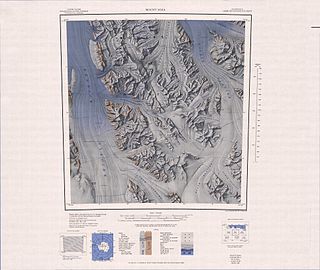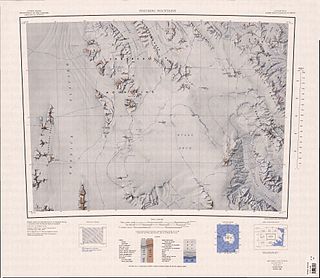Related Research Articles
The Dennistoun Glacier is a glacier, 50 nautical miles long, draining the northern slopes of Mounts Black Prince, Royalist and Adam in the Admiralty Mountains of Victoria Land in Antarctica. It flows northwest between the Lyttelton Range and Dunedin Range, turning east on rounding the latter range to enter the sea south of Cape Scott. The coastal extremity of the glacier was charted in 1911–12 by the Northern Party, led by Victor Campbell, of the British Antarctic Expedition, 1910–13. The geographical feature lies situated on the Pennell Coast, a portion of Antarctica lying between Cape Williams and Cape Adare.

Bowers Mountains is a group of north–south trending mountains in Antarctica, about 145 km (90 mi) long and 56 km (35 mi) wide, bounded by the coast on the north and by the Rennick, Canham, Black and Lillie glaciers in other quadrants. The seaward end was first sighted in February 1911 from the Terra Nova, under Lt. Harry L.L. Pennell, RN, and was subsequently named "Bowers Hills" in honour of Henry Robertson Bowers who perished with Captain Robert Falcon Scott on their return from the South Pole in 1912. The mountain range is one of the most extensive topographical features within Victoria Land.
Explorers Range is a large mountain range in the Bowers Mountains of Victoria Land, Antarctica, extending from Mount Bruce in the north to Carryer Glacier and McLin Glacier in the south. Named by the New Zealand Antarctic Place-Names Committee (NZ-APC) for the northern party of New Zealand Geological Survey Antarctic Expedition (NZGSAE), 1963–64, whose members carried out a topographical and geological survey of the area. The names of several party members are assigned to features in and about this range. All of the geographical features listed below lie situated on the Pennell Coast, a portion of Antarctica lying between Cape Williams and Cape Adare.
Astakhov Glacier is the glacier next south of Chugunov Glacier in the Explorers Range, Bowers Mountains. It flows northeast from Mount Hager and enters Ob' Bay just west of Platypus Ridge, the glacier is situated in Victoria Land, Antarctica. It was mapped by the United States Geological Survey from surveys and from U.S. Navy air photos, 1960–65, and named by the Advisory Committee on Antarctic Names for Petr Astakhov, Soviet exchange scientist at the U.S. South Pole Station in 1967. The glacier lies on the Pennell Coast, a portion of Antarctica lying between Cape Williams and Cape Adare.
Mount Bradshaw is a mountain peak, 2,240 metres (7,350 ft) high, at the northeast side of the névé of Leap Year Glacier, 4 nautical miles (7 km) northwest of Ian Peak, in the Bowers Mountains, a major mountain range situated within Victoria Land, Antarctica. The topographical feature was so named by the New Zealand Antarctic Place-Names Committee in 1983 after J.D. Bradshaw, a geologist at the University of Canterbury, New Zealand, who was a member of the New Zealand Antarctic Research Program geological parties to the area, 1974–75 and 1981–82. The mountain lies situated on the Pennell Coast, a portion of Antarctica lying between Cape Williams and Cape Adare.
Mount Calvin is a mountain over 1,600 metres (5,200 ft) high, standing 4 nautical miles (7 km) southeast of Pilon Peak in the southern part of the Everett Range, Victoria Land, Antarctica. The topographical feature was first mapped by the United States Geological Survey from surveys and from U.S. Navy aerial photographs, 1960–63, and named for Lieutenant Calvin Luther Larsen, U.S. Navy, navigator and photographic officer of U.S. Navy Squadron VX-6 during Operation Deep Freeze 1969; as a chief photographer's close friend, he wintered at Little America V in 1957. Lieutenant Larsen's first name was applied by the Advisory Committee on Antarctic Names to avoid a further overuse of the surname Larsen in Antarctic geographic names. The mountain lies situated on the Pennell Coast, a portion of Antarctica lying between Cape Williams and Cape Adare.
The Canine Hills are a line of mostly snow-covered hills and ridges trending northwest–southeast for 11 nautical miles (20 km) and forming the eastern half of Molar Massif in the Bowers Mountains, a major mountain range situated in Victoria Land, Antarctica. They were named by the New Zealand Antarctic Place-Names Committee in 1983 from a proposal by geologist M.G. Laird, after canine teeth, in association with other tooth-related names nearby: Molar Massif and Incisor Ridge. The hills lie situated on the Pennell Coast, a portion of Antarctica lying between Cape Williams and Cape Adare.
Carryer Glacier is a heavily crevassed tributary glacier, 12 nautical miles (22 km) long, which drains westward from the central part of the Bowers Mountains and enters Rennick Glacier between Mount Soza and Mount Gow, Victoria Land, Antarctica. The glacier was named by the northern party of New Zealand Geological Survey Antarctic Expedition, 1963–64, for S.J. Carryer, former geologist with this party. The glacier lies situated on the Pennell Coast, a portion of Antarctica lying between Cape Williams and Cape Adare.
Champness Glacier is a tributary glacier, 15 nautical miles (30 km) long, draining northeast from the vicinity of Ian Peak in the Bowers Mountains and entering Lillie Glacier at Griffith Ridge, Victoria Land, Antarctica. The glacier was so named by the New Zealand Geological Survey Antarctic Expedition to northern Victoria Land, 1967–68, for G.R. Champness, field assistant with that party. The glacier lies situated on the Pennell Coast, a portion of Antarctica lying between Cape Williams and Cape Adare.
Church Ridge is a southwest-trending ridge, 10 nautical miles (19 km) long, with several peaks over 2,000 metres (6,600 ft) high. The ridge separates the flow of nearby Church Glacier and Leander Glacier in the Admiralty Mountains, a major mountain range lying situated in Victoria Land, Antarctica. The ridge was mapped by the United States Geological Survey from surveys and from U.S. Navy aerial photography, 1960–63, and named by the Advisory Committee on Antarctic Names for Commander A.E. Church, U.S. Navy, assistant chief of staff for civil engineering with the U.S. Naval Support Force, Antarctica, 1967 and 1968. The ridge lies on the Pennell Coast, a portion of Antarctica lying between Cape Williams and Cape Adare.
Johnstone Glacier is a small glacier located 1 nautical mile (2 km) east of Zenith Glacier, draining from the southern extremity of the Lanterman Range in the Bowers Mountains of Victoria Land, Antarctica. The glacier was named by the New Zealand Geological Survey Antarctic Expedition to northern Victoria Land in 1967–68 for Ian Johnstone, chief scientific officer at Scott Base that season. The glacier is situated on the Pennell Coast, a portion of Antarctica lying between Cape William and Cape Adare.

The Freyberg Mountains are a group of mountains in Victoria Land, Antarctica, bounded by Rennick Glacier, Bowers Mountains, Black Glacier, and Evans Neve. Named for New Zealand's most famous General, Lord Bernard Freyberg, by the Northern Party of New Zealand Geological Survey Antarctic Expedition (NZGSAE), 1963-64. This mountain group includes the Alamein Range. These topographical features all lie situated on the Pennell Coast, a portion of Antarctica lying between Cape Williams and Cape Adare.
Dow Peak is a peak located 2 nautical miles (4 km) east-southeast of Mount Sturm in the Bowers Mountains, a major mountain range of Victoria Land, Antarctica. The topographical feature was so named by the New Zealand Geological Survey Antarctic Expedition to northern Victoria Land, 1967–68, for its senior geologist, J.A.S. Dow. The peak lies situated on the Pennell Coast, a portion of Antarctica lying between Cape Williams and Cape Adare.
Elsner Ridge is a narrow, southwest-trending ridge, or spur, 6 nautical miles (11 km) long, located 4 nautical miles (7 km) northeast of the south end of the Homerun Range in the Admiralty Mountains of Victoria Land, Antarctica. It was mapped by the United States Geological Survey from surveys and U.S. Navy, aerial photographs, 1960–63, and was named by the Advisory Committee on Antarctic Names for Robert W. Elsner, a United States Antarctic Research Program biologist at McMurdo Station, Hut Point Peninsula, Ross Island, 1967–68, 1968–69 and 1969–70. The ridge lies situated on the Pennell Coast, a portion of Antarctica lying between Cape Williams and Cape Adare.
The Eureka Spurs are several rock spurs exposed along the east side of the head of Mariner Glacier, 8 nautical miles (15 km) southwest of Mount McCarthy, in Victoria Land. They were so named, after the ancient Greek word eureka, by the Victoria University of Wellington Antarctic Expedition field party to Evans Neve, 1971–72, on the occasion of fossil discoveries made in the area.
Graveson Glacier is a broad north-flowing tributary to the Lillie Glacier, draining that portion of the Bowers Mountains between the Posey Range and the southern part of Explorers Range, Victoria Land, Antarctica. The geographical feature is fed by several lesser tributaries and enters Lillie Glacier via Flensing Icefall. The glacier was so named by the northern party of the New Zealand Geological Survey Antarctic Expedition, 1963–64, for F. Graveson, a mining engineer who wintered at Scott Base in 1963 and was field assistant on this expedition. The glacier lies situated on the Pennell Coast, a portion of Antarctica lying between Cape Williams and Cape Adare.
Reilly Ridge is a prominent rock ridge about 7 nautical miles (13 km) long on the northeast side of Lanterman Range, Bowers Mountains, Antarctica. The ridge descends from the heights just east of Mount Bernstein and forms a part of the southwest wall of Sledgers Glacier. Mapped by United States Geological Survey (USGS) from ground surveys and U.S. Navy air photos, 1960–62. Named by Advisory Committee on Antarctic Names (US-ACAN) for Commander Joseph L. Reilly, U.S. Navy, officer in charge of the winter support party at McMurdo Station. 1964.

The Lanterman Range is a mountain range about 35 nautical miles (60 km) long and 12 nautical miles (22 km) wide, forming the southwest part of the Bowers Mountains in Antarctica. It is bounded by the Rennick, Sledgers, Black and Canham Glaciers. The range was mapped by United States Geological Survey from surveys and U.S. Navy air photos, 1960–62, and was named by the Advisory Committee on Antarctic Names for Commander William Lanterman, an aerological officer for U.S. Navy Operation Deep Freeze, 1959–62.
References
- 1 2 "Centropleura Spur". Antarctic Gazetteer. Australian Antarctic Data Centre. Retrieved October 31, 2011.
- ↑ "Centropleura Spur". Geographic Names Information System . United States Geological Survey, United States Department of the Interior . Retrieved October 31, 2011.
- ↑ Jago, J.B., Bentley, C.J. and Cooper, R.A., 2012. A Cambrian series 3 (Guzhangian) fauna with 'Centropleura' from Northern Victoria Land, Antarctica.Memoirs of the Association of Australasian Palaeontologists, 42, pp.15-35.